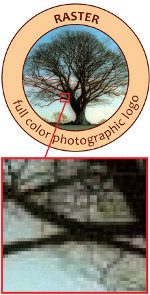Raster vs. Vector Artwork for Promotional Products
FollowMolly,
Feb 10, 2011
Great-looking promotional products start with great art. But that art has to be delivered in a format that will work with the imprinting process.
Generally, electronic artwork files fall into two classes, raster images and vectored images. Properly vectored art is required for the majority of promotional product purchases.
Not sure if your art is suitable for your order? Read on!
 Raster (Bitmap) Graphics
Raster (Bitmap) Graphics
Common raster file extensions: jpg, jpeg, gif, png, tif, tiff, bmp, psd and sometimes pdf.
Definition: representation of images as an array of pixels (tiny dots or squares of color), typically used for the representation of photographic images.
In other words: Raster images are the best way to clearly reproduce photographs or artwork that looks like photography. (See raster example, right.) The pixels (the dots or squares of color) in the image allow the smooth blending of colors and better representation of an image that looks like a picture.
What this means to you and your promotional products: When raster images are made larger, you can see the pixels. (This is when you'll hear the phrase like "That image is pixilated.") There is nothing that can be done to improve this because the color of the pixels gives the image the ability to look like a photograph. Usually, these types of images need to be "vectored," or converted into a vector art file format to be suitable for decorating promotional products.
Additionally, raster images can be difficult to print using spot colors because there are so many different colors in the image.
 Vector Graphics
Vector Graphics
Common vector file extensions: eps, ai and sometimes pdf
Definition: the use of a geometric description to represent an image. Or in other words, a set of instructions on how to draw the image.
In other words: A vector image (see vector example, right) doesn't have any pixels, therefore it can be blown up or shrunk down to any size and it will not lose its quality. This type of image doesn't have any pixels because it is an outline (traced) image of a raster file.
What this means to you and your promotional products: Vector images can be printed at any resolution (as large or as small as you need it). The number of colors can be easily increased or decreased to adjust printing budget.
Vector images are not the best format for photographs or photo-like images with blends of color.
How do I know if an image is raster- or vector-based?
Check the file name. If it has jpg, jpeg, gif, png, tif, tiff, bmp or psd, file extension it's a raster image. If it has an eps or ai, file extension it is a vectored image. If it's a pdf file, it could go either way. So try another step like:
- Enlarge or zoom in on the image. Do you see pixels? If so, it's a raster image.
- Is it a photograph or photograph-like picture? It's probably a raster image.
If all else fails, ask your Leaderpromos Account Executive. We can help with all your artwork needs!


